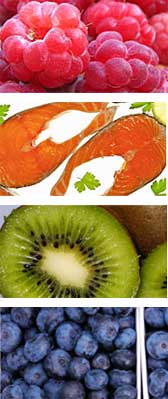 |
| Nutrition | Vitamins | Health | Diet | Weight Loss | Supplements | Nutritional Supplements | Food | Healthy | Vitamin | Minerals | Glyconutrients | Nutrition Supplements | Nutrition Guide |

|
Reading Food Labels: How a Small Change Can Make a Big Difference
Most people simply don't pay attention to what they eat. They choose food solely on the basis of taste (or worse, packaging). While everyone agrees that food should certainly taste good, there is also a need for our food to be nutritionally sound. If you are not accustomed to evaluating your food choices, grab a package of you favorite food with a Nutrition label on it and let's get started!
When evaluating a nutrition label, pay attention first to the serving size. A particular food, for instance ice cream, may only have 150 calories per serving, but if the serving size is � cup and you eat a whole cup, you have had 300 calories. Paying attention to this one section of the food label alone can help you drastically reduce your caloric intake and help you to lose unwanted pounds. However, keep in mind that if a food is high in calories per serving it does not mean that you should never eat it. Just reserve those treats for occasional use, making sure that eating it does not add up to more calories than you burn that day. Additionally, all foods can be broken down into three components called macronutrients. These macronutrients are proteins, fats and carbohydrates. There are healthy and not-so-healthy types of each of these macronutrients and they are all listed on food labels. (Micronutrients, which are commonly referred to as vitamins and minerals, will not be discussed here, but also can be found on food labels.) Next pay attention to the fat content of a particular food. You'll likely see listings for total, saturated and trans fats. Although you don't need to stay away from fat altogether (we need some fat in our diets to survive), steer clear of saturated and trans fats as much as possible. Saturated and trans fats increase your risk of developing conditions such as diabetes and heart disease. Better fats will be listed as polyunsaturated and monosaturated on food labels. Try getting your daily fat intake from nuts, seeds and plant oils instead of butter, high fat meats and processed snack foods. Where carbohydrates are concerned, think whole grains instead of processed or refined. On food labels you will see the total amount of carbohydrates listed with the amount of dietary fiber underneath. Foods that are more processed or refined will have less fiber. White bread and pasta as well as cookies, cakes and candies will be high in processed carbohydrates and low in fiber. Look for items that boast 100% whole grains when shopping for crackers, bread and pasta to reduce your chance of developing diseases such as diabetes, colon cancer and high cholesterol. Also, be careful of how many calories you drink. Sodas, sports drinks and alcohol contain carbohydrate calories without the benefit of fiber for the most part. These drinks are typically loaded with refined sugar. Stick with water and milk, or 100% juice in limited quantities no more than 1 glass a day. Some meats, and most fruits and vegetables, do not carry nutrition labels. However, a good reference book or web site will list macronutrient values for almost every fruit or vegetable imaginable. Every day, you need about three to nine grams of protein for every ten pounds of body weight. Most Americans eat more than enough to satisfy this requirement. Make sure your protein intake is in balance with what your body requires. For meals that don't come with a Nutrition label, a quick search on the internet will help you find the calorie content of foods from many different restaurants. Using this information, you can still eat out at your favorite places without overindulging in too many calories. The key to good health is information. The more you know, the easier it is to be healthy and fit. Learn about your favorite foods so that you can make good food choices that will enhance your overall health. copyright 2006 Jennifer Wetmore, DPT
|
||||||||||||
- 2024 � NutritionDecision.Com
- Privacy Policy
- Terms of Service

